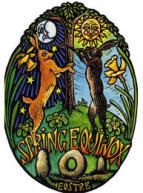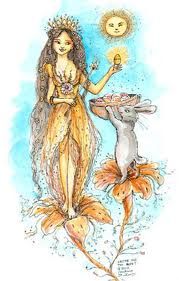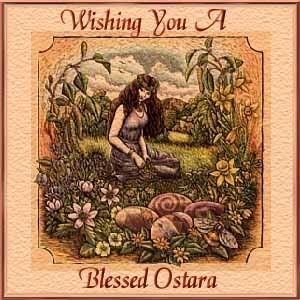Cross posted from The Stars Hollow Gazette
 Spring arrives promptly at on March 20 at 7:02 a.m. EDT/4:02 a.m. PDT. As you know the Spring Equinox is also called the “Vernal Equinox”, ver bring the Latin derivative for “spring.” It occurs when the sun crosses the celestial equator and night and day are equal. It is really just a moment in time and if you blink, you missed it. In the Southern Hemisphere where the seasons reverse it is the start of Autumn.
Spring arrives promptly at on March 20 at 7:02 a.m. EDT/4:02 a.m. PDT. As you know the Spring Equinox is also called the “Vernal Equinox”, ver bring the Latin derivative for “spring.” It occurs when the sun crosses the celestial equator and night and day are equal. It is really just a moment in time and if you blink, you missed it. In the Southern Hemisphere where the seasons reverse it is the start of Autumn.
Spring comes with lots of traditions, cultural, religious and mythical. The egg, a symbol of fertility is the subject of one of the biggest myths. The balancing of an uncooked egg derives from the notion that due to the sun’s equidistant position between the poles of the earth at the time of the equinox, special gravitational forces apply. Actually, it can be done anytime of the year on a flat, level surface, a steady hand and no vibrations. It’s the same with that broom balancing That works best with a new broom that has uniform, even bristles.
I once stood an egg on the dining room table and left it there. One of my cat, Mom Cat, sat staring at it for quite some time. After several minutes, she very gently reached out with one paw and tapped it. It rolled off the table and smashed on the floor before I could reach it. As I cleaned up the mess, Mom Cat sat on the edge of the table watching, as if to say, ‘yes, gravity still works.”
There are lots celebrations in many countries and cultures including the internet. Google celebrates with its popular animated “doodles.”
In Iran, ancient new year’s festival of Nowruz is celebrated:
According to the ancient Persian mythology Jamshid, the mythological king of Persia, ascended to the throne on this day and each year this is commemorated with festivities for two weeks. These festivities recall the story of creation and the ancient cosmology of Iranian and Persian people.
In many Arab countries, Mother’s Day is celebrated on the Spring equinox and the Jewish celebration of Passover starts on the first full moon after the Northern Hemisphere vernal equinox.
Most Christian churches calculate Easter as the first Sunday after the first full moon on or after the March equinox but the Eastern Orthodox Churches use the older Julian calendar so the actual date of Easter differs.
In Japan the Spring Equinox became an official holiday in 1948, Shunbun no hi.
We Pagans celebrate Ostara, one of the Eight Sabats of the Wheel, as a season of rebirth. The name is derived from Eostre, the Anglo-Saxon goddess of spring and fertility, and many symbols are associated with Ostara, including colored eggs and, what else? Rabbits:
In medieval societies in Europe, the March hare was viewed as a major fertility symbol — this is a species of rabbit that is nocturnal most of the year, but in March when mating season begins, there are bunnies everywhere all day long. The female of the species is superfecund and can conceive a second litter while still pregnant with a first. As if that wasn’t enough, the males tend to get frustrated when rebuffed by their mates, and bounce around erratically when discouraged.
Colored eggs are one of the symbols of fertility with an interesting, and this unconfirmed scary, history from Witches’ Voice :
(T)he traditional coloring and giving of eggs at Easter has very pagan associations. For eggs are clearly one of the most potent symbols of fertility, and spring is the season when animals begin to mate and flowers and trees pollinate and reproduce. In England and Northern Europe, eggs were often employed in folk magic when women wanted to be blessed with children. There is a great scene in the film The Wicker Man where a woman sits upon a tombstone in the cemetery, holding a child against her bared breasts with one hand, and holding up an egg in the other, rocking back and forth as she stares at the scandalized (and very uptight!) Sargent Howie. Many cultures have a strong tradition of egg coloring; among Greeks, eggs are traditionally dyed dark red and given as gifts.
As for the Easter egg hunt, a fun game for kids, I have heard at least one pagan teacher say that there is a rather scary history to this. As with many elements of our “ancient history, ” there is little or no factual documentation to back this up. But the story goes like this: Eggs were decorated and offered as gifts and to bring blessings of prosperity and abundance in the coming year; this was common in Old Europe. As Christianity rose and the ways of the “Old Religion” were shunned, people took to hiding the eggs and having children make a game out of finding them. This would take place with all the children of the village looking at the same time in everyone’s gardens and beneath fences and other spots.
It is said, however, that those people who sought to seek out heathens and heretics would bribe children with coins or threats, and once those children uncovered eggs on someone’s property, that person was then accused of practicing the old ways. I have never read any historical account of this, so I cannot offer a source for this story (though I assume the person who first told me found it somewhere); when I find one, I will let you know!
Whatever you believe, or not, get out there in the garden or the park and celebrate the warmth of the sun, the longer days, renewal and rebirth.


 Spring officially sprang at 1:14 AM Eastern Daylight Time on Tuesday. Partially because this is a “Leap Year”, in some times zones the
Spring officially sprang at 1:14 AM Eastern Daylight Time on Tuesday. Partially because this is a “Leap Year”, in some times zones the 